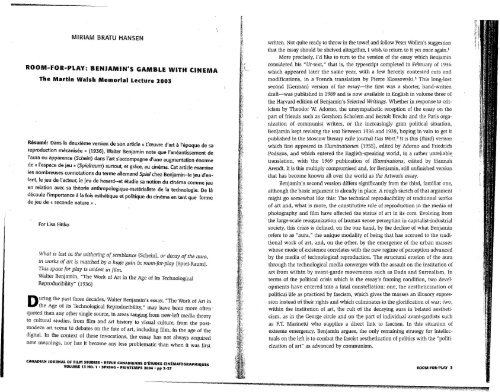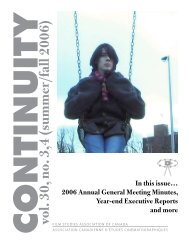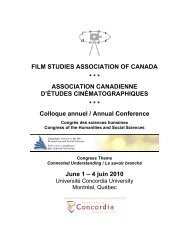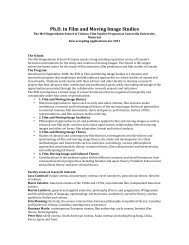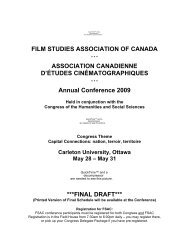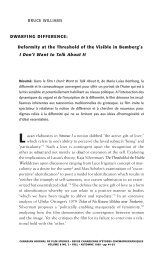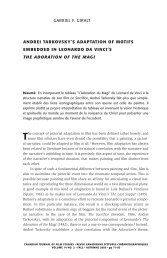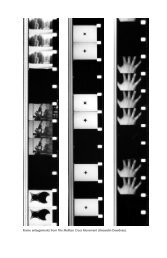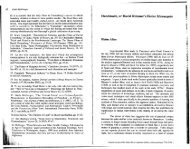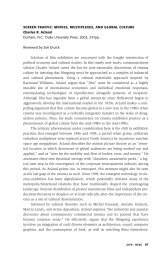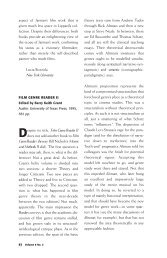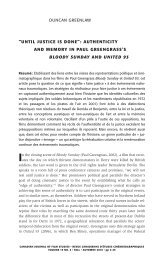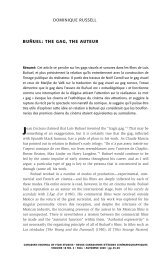PDF: Room-for-Play: Benjamin's Gamble with Cinema - Film Studies ...
PDF: Room-for-Play: Benjamin's Gamble with Cinema - Film Studies ...
PDF: Room-for-Play: Benjamin's Gamble with Cinema - Film Studies ...
Create successful ePaper yourself
Turn your PDF publications into a flip-book with our unique Google optimized e-Paper software.
one in which receptivity and creativity are in exact correlation. Grounding the<br />
per<strong>for</strong>mance in a "radical unleashing of play-something the adult can only<br />
wonder at" (SW2:205), children's theafer could become "truly revolutionary," as<br />
"fhe secret signal of what is to come [which] speaks from the gesture of the<br />
child" (SW2:206).<br />
At first sight, this vision of acting appears to differ from <strong>Benjamin's</strong> notions<br />
of adult acting <strong>with</strong>in a rule-governed artistic institution, be it the traditional stage,<br />
the experimental one of epic theater, or the cinema. to In both versions of the<br />
Artwork essay, Benjamin elaborates at lengfh on the screen actor, who faces his<br />
or her audience ("the masses") in their absence, per<strong>for</strong>ming instead be<strong>for</strong>e the<br />
apparatus and a group of specialists. The discussion of the actor's per<strong>for</strong>mance<br />
be<strong>for</strong>e fhe camera <strong>for</strong>egrounds the connotation the word has in English, that is,<br />
per<strong>for</strong>mance as an achievement or Leistung which is being "tested" at both the<br />
level of production and that of reception; in other words, it becomes an object of<br />
controlled exhibition or, one might say, dis-play. Yet, as I will show, in the earlier<br />
version of the essay Benjamin still links the success of that per<strong>for</strong>mance to the<br />
trans<strong>for</strong>mative and apotropaic dimensions of children's play. What is more, he<br />
extends the concept of play to the behavior of the spectating collective in front of<br />
the screen, including involuntary, sensory-motoric <strong>for</strong>ms of reception.<br />
The third meaning in the complex of Spiel is that of gambling, the game<br />
of chance or, to use <strong>Benjamin's</strong> preferred term, Hasardspiel. His reflections on<br />
the figure of fhe Spieler or gambler are familiar primarily from his essay "On<br />
Some Motifs in Baudelaire" (1939/1940) where they con<strong>for</strong>m to that essay's<br />
generally critical, pessimistic tenor regarding the decline of experience<br />
Erfahmng in <strong>Benjamin's</strong> emphatic sense-in capitalist-industrial modernity. As<br />
a symptom of that decline, fhe gambler exemplifies a mode of attention ever<br />
ready to parry mechanical shocks, similar to the reflex reaction required of the<br />
worker on the assembly line and, like the latter, no longer relying on experience<br />
in the sense of accumulated wisdom, memory, and tradition,u<br />
Conceptually, however, <strong>Benjamin's</strong> interest in gambling belongs to a series<br />
of earlier attempts, beginning <strong>with</strong> One-Way Street and continuing into the<br />
Arcades Project, to theorize an alternative mode of apperception, assimilation,<br />
and agency which would not only be equal to the technologically changed and<br />
changing environment, but also open to chance and a different future. If<br />
experience had fallen in value, proven useless by trench warfare, hunger,<br />
inflation, and massive social and political changes, it was nonetheless<br />
imperative to conceptualize some contemporary equivalent to that mode of<br />
knowledge.J2 A reinvention of experience-experience under erasure-was<br />
needed above all to counter the already "bungled reception of technology" and<br />
<strong>with</strong> it the spiral of anaesthetics (the numbing of the sensorium in defense<br />
against shock) and aesthetization which, in <strong>Benjamin's</strong> (and Susan Buck<br />
Morss's) analysis, was key to the success of fascismY<br />
6 MIRIAM BRATU HANSEN<br />
A crucial term in this project, entwined <strong>with</strong> the multiple meanings of<br />
Spiel, is the already-mentioned concept of innervation. 14 This term broadly<br />
refers to a non-destructive, mimetic incorporation of the world-which<br />
Benjamin explored, over fhe course of a decade, through exemplary practices<br />
such as writing and reading, yoga, eros, children's play, experiments <strong>with</strong><br />
hashish, surrealism, and cinema. In an unpublished fragment written around<br />
1929-30, "Notes on a Theory of Gambling" (... des Spiels), Benjamin states that<br />
the decisive factor in gambling is "fhe level of motor innervation" (SW 2:297).<br />
The successful contact of the gambler's motor stimuli <strong>with</strong> "fate" requires,<br />
be<strong>for</strong>e all else, a "correct physical predisposition" (SW 2:298), a heightened<br />
receptivity that allows "fhe spark [to leap] <strong>with</strong>in the body from one point to the<br />
next, imparting movement !low to this organ, now to that one, concentrating the<br />
whole of existence and delimiting it. It is condensed to the time allowed the right<br />
hand be<strong>for</strong>e the ball has fallen into the slot."15 Benjamin insists on the neurophysiological<br />
character of such innervation, ·which is all the more decisive "the<br />
more emancipated it is from optical perception" (SW 2:297).<br />
In ofher words, rather than relying on the master sense of vision, say, by<br />
"reading" the table, let alone an "'interpretation' of chance" CAP 513), gambling<br />
turns on a "bodily presence of mind," a faculty that Benjamin elsewhere<br />
attributes to "the ancients."16 In marginal cases of gambling, this presence of<br />
mind becomes "divination-that is to say, one of the highest, rarest mo,ments in<br />
life" (SW 2:298). The ability to commune <strong>with</strong> cosmic <strong>for</strong>ces, however, is<br />
mobilized in the register of play, of simulation: "gambling generates by way of<br />
experiment the lightning-quick process of stimulation at the moment of danger"<br />
(SW 2:298); it is, as it were, "a blasphemous test of our presence of mind."l? The<br />
moment of accelerated danger, a topos in <strong>Benjamin's</strong> epistemology and theory<br />
of history, is defined in the realm of roulette by a specific temporality: "the tendency<br />
of gamblers to place their bets...at the very last moment" [AP 512£.).<br />
Accordingly, the danger is not so much one of losing than one of "not winning,"<br />
of "missing [one's] chance" or "arriving 'too late'" (SW 2:297,298).18<br />
With a view to <strong>Benjamin's</strong> concept of cinema, it is significant that he seems<br />
less interested in pursuing analogies <strong>with</strong> assembly line work or the stock<br />
market than in linking fhe game of chance to the gambler's ability to seize the<br />
current of fate, related to ancient practices of divination which involve the<br />
human being in his or her material entirety. Whether or not we are persuaded by<br />
this linkage, it represents one of <strong>Benjamin's</strong> more daring (and, as history would<br />
have it, most desperate) ef<strong>for</strong>ts to trace an archaic, species-based faculty <strong>with</strong>in a<br />
modern, industrial-capitalist context in which mimetic relations (in <strong>Benjamin's</strong><br />
sense) seem to have receded into "non-sensuous similarity."19 The rare gift of<br />
proper gambling, pursued-and misused-by individuals in a hermetically isolated<br />
manner and <strong>for</strong> private gain, becomes a model of mimetic innervation <strong>for</strong><br />
a col1ective which seems to have all but lost, literally, its senses; which lacks<br />
ROOM-FOR-PLAY 7
increase of "elements of play in recent art: futurism, atonal music, poesie pure,<br />
detective novel, film" (GS 1:1048). Benjamin correlates these two developments<br />
through an economy 'of loss and gain: "What is lost in the <strong>with</strong>ering of semblance,<br />
or decay of the aura, in works of art is matched by a huge gain in room-<strong>for</strong>-play<br />
[Spiel-Raum]. This space <strong>for</strong> play is widest in film. In film, the element of semblance<br />
has been entirely displaced by the element of play" (SW 3:127).<br />
<strong>Benjamin's</strong> decision to situate film on the side of play, rather than<br />
the cult of illusion, appears, at the very least, counter-intuitive, especially in<br />
view of major tendencies in actual film practice of the early 1930s, whether<br />
fascist, liberal-capitalist, or socialist-realist. The argument begins to make<br />
sense, however, in the context of the Artwork essay (which, at any rate, rather<br />
refers itself to early cinema as well as montage or otherwise non-classical,<br />
marginalized film practices), if we consider it in relation to <strong>Benjamin's</strong> larger<br />
ef<strong>for</strong>t to theorize technology.<br />
In the essay's familiar version, technology primarily figures in its<br />
destructive, "liquidating" effect on traditional art, summed up in the erosion of<br />
the aura, and its concomitant potential <strong>for</strong> democratizing culture, based on a<br />
structural affinity between the new reproduction technologies and the masses.<br />
In the Ur-text, however, the concept of technology is grounded more fully in the<br />
framework of what Benjamin refers to as "anthropological materialism." In his<br />
1929 essay on Surrealism, he had invoked that tradition (Johann Peter Hebel,<br />
Georg Buchner, Nietzsche, Rimbaud) as an alternative to more orthodox<br />
Marxist, "metaphysical" versions of materialism in the manner of Vogt and<br />
Bukharin. 29 It is indicative that Adorno, in a letter of September 1936, chose the<br />
term "anthropological materialism" to sum up all points on which he found himself<br />
at odds <strong>with</strong> Benjamin;<br />
The bone of contention <strong>for</strong> Adorno was what he considered<br />
<strong>Benjamin's</strong> "undialectical ontology of the body."30 While <strong>Benjamin's</strong> concept of<br />
the body no doubt has roots in theology and mysticism, this does not prevent<br />
him from thinking about the body in both historical and political terms. 31 But he<br />
does so by situating the fate of the individual body (and the bodily sensorium)<br />
in bourgeois society <strong>with</strong>in a larger history of the human species, which entails<br />
thinking about humans in relation to all of creation and about human history in<br />
relation to that of the cosmos. 32 Likewise, as we shall see, he relates the temporal<br />
individual body to the constitution of a-metaphoric-collective body, or bodily<br />
collective, which is both agent and object of the human interaction <strong>with</strong> nature.<br />
Within this anthropological-materialist 'framework, then, technology endows the<br />
collective <strong>with</strong> a new physis that demands to be understood and re/appropriated,<br />
literally incorporated, in the interest of the collective; at the same time,<br />
technology provides the medium in which such reappropriation can and must<br />
take place. Such a reflexive understanding of technology makes visible a different<br />
logic-a logic of play-in <strong>Benjamin's</strong> conception of the historic role of film.<br />
10 MIRIAM BRATU HANSEN<br />
This role is determined, along <strong>with</strong> the polarity of semblance and play,<br />
by what he calls "the world-historical conflict between first and second technologies"<br />
(SW 3:127). The distinction between first and second technology is developed<br />
in the Artwork essay's original section VI, which sets up the distinction in<br />
art between "cult value" and "exhibition value." Like art, Benjamin states, the<br />
first technology emerges in the context of ancient magical procedures and rituals.<br />
In the ef<strong>for</strong>t to make an overpowering nature serve human needs and ends, the<br />
first technology "made maximum possible use of human beings"; the second<br />
technology, by contrast, involves the human being as little as possible. Hence,<br />
he asserts, "the achievements of the first technology might be said to culminate<br />
in human sacrifice; those of the secorid, in the remote-controlled aircraft which<br />
needs no human crew" (SVV;3:107). Yet, where a contemporary reader might<br />
associate the latter <strong>with</strong> the latest in American-style electronic warfare (drones,<br />
cruise missiles), Benjamin makes an amazing turn. If the first technology is<br />
defined by the temporality of "once and <strong>for</strong> all" (Ein fUr alleman, "the irreparable<br />
lapse or sacrificial death," the second technology operates in the register of<br />
"once is as go'od as never" (Einmal ist keinmal) since it works "by means of<br />
experiments and endlessly varied test procedures" (SW 3:107; GS 7:359). Its origin<br />
is to be sought at the point where, "by an unconscious ruse, human beings first<br />
began to distance themselves from nature. In other words," he concludes, "[its<br />
origin] lies in play" (SW 3:107).<br />
Unlike Frankfurt School critiques of technology from Dialectic of<br />
Enlightenment through the work of Jurgen Habermas, Benjamin does not<br />
assume an instrumentalist trajectory from mythical cunning to capitalistindustrialist<br />
modernity. Instead of "mastery of nature," which the first technology<br />
pursued out of harsh necessity, the second "aims rather at an.interplay<br />
(Zusammenspiel] between nature and humanity."33 Rehearsing this interplay,<br />
Benjamin contends, is the "decisive social function of art today." Hence the particular<br />
significance of film: "The function of film is to train human beings in the<br />
apperceptions and reactions needed to deal <strong>with</strong> a vast apparatus whose role in<br />
their lives is expanding almost daily" (SW 3:108, itahcs in original).<br />
We could easily read this statement as a behaviorist conception of<br />
adapting the human sensorium to the regime of the apparatus or, in the tradition<br />
of play theory, as a version of training theory or Einiibungs-Theorie (GrooS).34<br />
And there is no reason not to, considering <strong>Benjamin's</strong> interest, thanks in part to<br />
Asja Lacis, in the Soviet avant-garde discourse of biomechanics (Meyerhold,<br />
Kuleshov, Eisenstein) and his strategically belated endorsement of Productivism<br />
and Operativism (Tretyakov). 35 But it would be a mistake to read the statement<br />
as simply an inversion of an idealist or aristocratic hierarchy of play and work<br />
(such as Huizinga's), to the effect that film, as a "play-<strong>for</strong>m" of technology,<br />
would be instrumental to the goal of increasing industrial productivity, albeit on<br />
behalf of a socialist society. Not<strong>with</strong>standing <strong>Benjamin's</strong> advocacy of positioning<br />
ROOM-FOR-PLAY 11<br />
ZaZ5J.
In the Artwork essay, the imbrication of body- and image-space, of human<br />
perceptual-physiological impulses and mechanical structures, and the related<br />
logic linking the demontage of the individual to the idea of collective innervation<br />
are exemplified in the figure of the screen actor. Like many early writers on film,<br />
Benjamin contrasts the screen actor's per<strong>for</strong>mance <strong>with</strong> that of the stage actor.<br />
Not only does the <strong>for</strong>mer <strong>for</strong>feit the aura of live per<strong>for</strong>mance, as well as the rapport<br />
<strong>with</strong> a corporeally present audience; his or her per<strong>for</strong>mance or accomplishment<br />
(Leistung) is to a much greater degree determined by a team of experts, from the<br />
director and cinematographer to the sound engineer and editor. The morcelization<br />
and recomposition of the actor's being, the welding of his body into image<br />
space, requires on his part a total bodily presence of mind (not unlike that of<br />
the successful gambler).<br />
For the screen actor faces a unique kind of mechanized test, similar to the<br />
aptitude tests to which the capitalist labor process subjects individuals daily and<br />
<strong>with</strong>out public accountability. By exhibiting the actor's test per<strong>for</strong>mancll" by<br />
turning the very ability to be exhibited into a test, film becomes an allegory of<br />
the social (mis)adaptation of technology:<br />
To per<strong>for</strong>m in the glare of arc lamps while simultaneously meeting the<br />
demands of the microphone is a test per<strong>for</strong>mance of the highest order. To<br />
accomplish it is to preserve one's humanity in the face of the apparatus.<br />
Interest in this per<strong>for</strong>mance is widespread. For the majority of citydwellers,<br />
throughout the work day in offices and factories, have to relinqUish their<br />
humanity in the face of an apparatus. In the evening these same masses fill<br />
the cinemas, to witness the film actor taking revenge on their behalf not<br />
only by asserting his humanity (or what appears to them as such) against<br />
the apparatus, but by placing that apparatus in the service of his triumph<br />
[SW 3:1ll].<br />
In other words, inasmuch as the screen actor's composite per<strong>for</strong>mance achieves<br />
an individual innervation of technology at the level of production, it may spark<br />
collective innervation at the level of reception, in the corporeal space of the audience<br />
assembled in the theater, through processes of mimetic identification specific to<br />
cinema. (This conception is diametrically reversed in the canonic version of the<br />
essay, in which the audience is assumed to side, in a more Brechtian fashion,<br />
<strong>with</strong> the testing gaze of the camera.)40<br />
<strong>Benjamin's</strong> conception of the screen actor is not as heroic as it may seem.<br />
The triumph of the actor's "humanity" (Menschlichkeit) is, after all, that of an<br />
"eliminated"human being, as he writes elsewhere, the human being "as the<br />
fifth wheel on the carriage of its technology. "41 <strong>Benjamin's</strong> ef<strong>for</strong>ts to imagine<br />
a different relationship between humans and technology are motivated, fundamentally,<br />
by the insight that the reception of technology had already failed on a<br />
] 4 MIRIAM BRATU HANSEN<br />
grand scale: The nineteenth century's dream of technology, fettered by capitalist<br />
relations of production, had met a terrible awakening in World War I, the "slave<br />
rebellion" of advanced technology.42 War, inflation, and capitalist rationalization<br />
have aggravated the human being's self-alienation, a Marxian category (derived<br />
from Hegel) which Benjamin updates by emphasizing the effects of the "bungled"<br />
reception of technology on the human sensorium and capability of experience<br />
(the spiral of shock and anaesthetics).<br />
Importantly, however, he gives that concept a dialectical twist which distinguishes<br />
it from merely pessimistic critiques of modernity. For one thing,<br />
grounded in secular Jewish messianism and literary gnosticism (Kafka, Freud),<br />
<strong>Benjamin's</strong> concept of self-alienation does not involve the assumption of an<br />
originary unalienated condition or a more identical, unified self. 43 For another,<br />
he valorizes film <strong>for</strong> making self-alienation materially and publicly perceivable,<br />
in other words, quotable and available <strong>for</strong> action: "In the representation of the<br />
human being by means of an apparatus his self-alienation has found a highly<br />
productive utilization" (SW 3:113; GS 7:369, italics in original).<br />
The screen actor whom Benjamin extols as a preeminent per<strong>for</strong>mer of selfalienation<br />
is, not surprisingly, Chaplin. A descendant of the figure of the eccentric,<br />
Chaplin ranks as one of the first occupants-"Trockenwohner" (provisional<br />
dweller)-of the "new fields of action [Spielriiume] that emerged <strong>with</strong> film" (SW<br />
3:118; GS 7:377-8). Chaplin's exercises in fragmentation are a case in point:<br />
He dissects human expressive movement [Ausdrucksbewegung] into a<br />
series of minute innervations. Every one of his movements is composed of<br />
a series of chopped-up bits of motion. Whether you focus on his walk or<br />
the way he handles his little cane or tips his hat-it is always the same<br />
jerky succession of tiny movements, which applies the law of the filmic<br />
sequence to that of human motorics. 45<br />
By mimicking technology's fragmenting effects on the human body-a signature<br />
celebrated by the contemporary artistic avant-garde, famously Leger and<br />
Soupault-Chaplin "interprets himself allegorically" (GS 1:1047). This is to<br />
say, he renders self-alienation productive by making it visible, thus enabling,<br />
in Michael Jennings' words, "the mass of humans to see their own alienation,<br />
to recognize the fragmented, oppressive character of history."46 Such cognition,<br />
however, depends upon a double process of bodily innervation-the<br />
interpenetration of the per<strong>for</strong>mer's physiological impulses <strong>with</strong> the structures<br />
of the apparatus, and the audience's mimetic, visceral assimilation of the<br />
product in the <strong>for</strong>m of collective laughter. (In terms of film practice, such<br />
innervation can of course work through widely varying styles: stoic, whimsical,<br />
hysterical-think of per<strong>for</strong>mers as diverse as Buster Keaton, Jacques Tati, and<br />
Jerry Lewis.)<br />
ROOM-FOR-PLAY ] 5
For Benjamin, the preferred genre of second technology is obviously comedy<br />
(the other being science fiction, as evidenced by his lifelong enthusiasm <strong>for</strong> the<br />
writer Paul Scheerbart) Y Already in his defense of Potemkin, Benjamin had<br />
attributed the superiority of American slapstick comedy, like that of Soviet revolutionary<br />
cinema, to its engagement <strong>with</strong> technology.48 "This kind of film is<br />
comic, but only in the sense that the laughter it provokes hovers over an abyss<br />
of horror" (SW 2: 17). Such language still harks back to Bergson whose famous<br />
essay links laughter to the dread of the mechanical, the threatening loss of the<br />
elan vital. In the Artwork essay, however, anything resembling a technopessimistic,<br />
lapsarian stance is dialecticized by the paradigm of play. Comedy<br />
and play are linked throUgh their antonym-Ernst, in its double meaning of<br />
both seriousness and earnestness. 49 Ernst corresponds to the logic of once-and<strong>for</strong>-all<br />
(the irreversible human sacrifice, the discus or shot that kills, tragedy,<br />
fascism). Spiel, on the other hand, enacts the logic of "Einmal ist keinmal,"<br />
drawing on the "inexhaustible reservoir of all the experimental procedures" of<br />
second technology (SW 3:127). We can easily think of a wide range of film<br />
comedies, not necessarily all silent (consider the Marx Brothers), which exemplify<br />
that logic by playing games as much <strong>with</strong> the order of things as <strong>with</strong> the order<br />
and meaning of words.<br />
Comedy and play have in common the principle of repetition. As many<br />
writers have pointed out, comic modes-irony, parody, satire, sight gags<br />
-involve structures of citationality: they work through quotation and reiteration.<br />
Benjamin considers it essential <strong>for</strong> a new theory of play "to explore the great law<br />
that presides over the rules and rhythms of the entire world of play: the law of<br />
repetition." For the child, "repetition is the soul of play"; nothing makes him<br />
happier than "'doing the same thing over and over again.'" Benjamin invokes<br />
Freud-only to depart from him in a crucial way. Comparing the child's compulsion<br />
to repeat <strong>with</strong> the sexual drive in erotic passion, both "powerful" and<br />
"cunning," he agrees <strong>with</strong> Freud's claim that there's indeed an "impulse<br />
'beyond the pleasure principle.''' But he proceeds to read that "beyond" rather<br />
ambiguously, if not deviously, through Goethe. "In fact, every profound experience<br />
longs to be insatiable, longs <strong>for</strong> repetition and return until the end of time, and<br />
<strong>for</strong> the restitution of an original condition from which it sprang." Repetition thus<br />
understood is not only an ef<strong>for</strong>t to domesticate trauma; "it also means enjoying<br />
one's victories and triumphs over and over again, <strong>with</strong> total intensity" (SW 2: 120).<br />
Freud dismisses repetition in pursuit of the pleasure principle as infantile<br />
(adults don't laUgh at a joke the second time around) and attributes the neurotic<br />
compulsion to repeat in the adult to the drive inherent in the living organism to<br />
restore a prior state of equilibrium, in other words, the death drive. 5o While<br />
Benjamin retains the linkage of repetition and trauma-playas "the trans<strong>for</strong>mation<br />
of a shattering experience into habit" (SW 2:120)-he reconfigures it in terms of<br />
a utopian notion of repetition as difference, one that does not privilege traumatic<br />
16 MIRIAM BRATU HANSEN<br />
werw = r -<br />
nNW<br />
experience as a primal event but makes it productive of a future. Whether<br />
fuelled by trauma or triumph, the emphasis is on the nexus of play and habit<br />
and, conversely, an understanding of habits as "petrified <strong>for</strong>ms of our first happiness,<br />
or our first dread, de<strong>for</strong>med to the point of being unrecognizable" (SW 2:120;<br />
GS 3:131).<br />
In <strong>Benjamin's</strong> philosophy of history, repetition belongs to those ambivalent,<br />
if not antinomic, categories that he nursed so stubbornly, and it is inseparable<br />
from his politics of happiness and historical redemption. 51 Reductively speaking,<br />
Benj amin's concept of repetition oscillates between two extremes: one,<br />
Nietzsche's eternal return congealed in the law of the commodity, <strong>with</strong> fashion<br />
as both disguise and perpetuation of the ever-same (Baudelaire); two, dialectically<br />
embedded in the <strong>for</strong>mer, repetition as the striving <strong>for</strong> a past happiness which<br />
Proust pursued to the point of asphyxiation-a repetition that Deleuze has taught<br />
us to read as the production of that past in the very movement of repetition. 52 The<br />
latter, turning on similarity (Ahnlichkeit) and hence difference, also recalls<br />
Kierkegaard's notion of repetition as a memory in the direction of the Juture<br />
("Erinnerung in Richtung nach vorn")-or, in Benjaminian terms, repetition in the<br />
mode of the "yet-once-again" (it might work this time) linked to the messianic<br />
idea of repairing a history gone to pieces. 53<br />
When we turn to cinema as a medium of repetition, we find both poles of<br />
the antinomy present though not elaborated or, rather, submergeg in the<br />
assumption of an Umschlag or trans<strong>for</strong>mation of quantity (sameness, massness)<br />
into quality (similarity, difference). In a quite basic sense, Benjamin<br />
regarded film as the medium of repetition par excellence on account of its technical<br />
structure: mechanical reproduction as replication that lacks an original;<br />
infinite reiterability and improvability at the level of production (numerous<br />
takes) as well as that of reception, that is, the seemingly unlimited distribution<br />
and exhibition of prints of the same film (an argument that, we would argue<br />
today, ignores the variability of both exhibition practices and demographically<br />
diverse, public events of reception). At the same time, and because of both its<br />
technological and collective status, he invested the cinema <strong>with</strong> the hope that it<br />
could yet heal the wounds inflicted on human bodies and senses by a technology<br />
bent on the mastery of nature; the hope that film, as a sensory-reflexive medium<br />
of second technology, that is, rooted in play, offers a second, though perhaps<br />
last, chance <strong>for</strong> reversing sensory alienation, the numbing of the human sensorium<br />
in defense against shock and the concomitant splitting of experience. "In the<br />
cinema," Benjamin writes in One-Way Street, "people who are no longer moved<br />
or touched by anything learn to cry again" (SW 1:476; GS 4:132).<br />
The Artwork essay resumes this motif and gives it a more concrete-and<br />
rather more violent-elaboration. In the section on the "optical unconscious,"<br />
originally entitled "Micky-Maus," Benjamin tries to make a case <strong>for</strong> film as the <strong>for</strong>m<br />
of play that could at the very least neutralize, on a mass basis, the traumatic<br />
ROOM-FOR-PLAY 17


